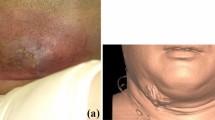Abstract
Sialolithiasis is the most common pathology of the salivary gland characterized by the development of salivary stones, known as calculi or sialoliths. Sialoliths commonly measure between 5 and 10 mm in size, and all stones over 10 mm can be reported as sialoliths of unusual size. Sialolith of more than 15 mm is defined as giant sialolith and is extremely rare. Most salivary sialolith occurs in the submandibular gland duct, especially located in the distal third of the duct. The main signs and symptoms are local pain and swelling. The treatment option to remove the sialolith is according to its size and location. For giant sialolith, surgical removal with or without the gland excision needs to be considered. Here, we report a case of giant submandibular gland sialolith of 35 mm in greatest dimension. And this is the first reported case of giant salivary gland duct sialolith discharged spontaneously.


Similar content being viewed by others
References
Sengupta S, Bose S (2018) Sialolithiasis of right submandibular duct of unusual size. Indian J Surg 80(2):190–191. https://doi.org/10.1007/s12262-018-1723-6
Bodner L (2002) Giant salivary gland calculi: diagnostic imaging and surgical management. Oral Surgery, Oral Medicine, Oral Pathology, Oral Radiology, and Endodontology 94(3):320–323. https://doi.org/10.1067/moe.2002.123863
Sigismund PE, Zenk J, Koch M, Schapher M, Rudes M, Iro H (2015) Nearly 3,000 salivary stones: some clinical and epidemiologic aspects. Laryngoscope 125(8):1879–1882. https://doi.org/10.1002/lary.25377
Rai M, Burman R (2009) Giant submandibular sialolith of remarkable size in the comma area of Wharton’s duct: a case report. J Oral Maxil Surg 67(6):1329–1332. https://doi.org/10.1016/j.joms.2008.11.014
Kraaij S, Brand HS, van der Meij EH, de Visscher JG (2018) Biochemical composition of salivary stones in relation to stone- and patient-related factors. Med Oral Patol Oral Cir Bucal 23(5):e540–e544. https://doi.org/10.4317/medoral.22533
Kraaij S, Karagozoglu KH, Kenter YAG, Pijpe J, Gilijamse M, Brand HS (2015) Systemic diseases and the risk of developing salivary stones: a case control study. Oral Surg Oral Med Oral Pathol Oral Radiol 119(5):539–543. https://doi.org/10.1016/j.oooo.2015.01.010
Kati B, Kalkan E, Pelit ES, Yagmur I, Ciftci H (2018) Do dental calculi predict the presence of renal stones? Arch Ital Urol Androl 90(3):159–162. https://doi.org/10.4081/aiua.2018.3.159
Marchal F, Kurt AM, Dulguerov P, Lehmann W (2001) Retrograde theory in sialolithiasis formation. Arch Otolaryngol Head Neck Surg 127(1):66–68. https://doi.org/10.1001/archotol.127.1.66
Author information
Authors and Affiliations
Corresponding author
Ethics declarations
Conflict of Interest
The authors declare that they have no conflict of interest.
Additional information
Publisher’s Note
Springer Nature remains neutral with regard to jurisdictional claims in published maps and institutional affiliations.
Rights and permissions
About this article
Cite this article
Zhang, W., Wang, K. & Yang, F. Spontaneous Discharged Submandibular Gland Duct Sialolith: Α Rare Case Report. Indian J Surg 82, 205–207 (2020). https://doi.org/10.1007/s12262-019-01927-y
Received:
Accepted:
Published:
Issue Date:
DOI: https://doi.org/10.1007/s12262-019-01927-y




